Why is investing in the best email marketing tool for your company important?
I always say that you need to meet the digital user where they are, and that is either in social, search, or email. Your choice of email marketing tool is as important as which social media marketing dashboard or SEO tool that you decide to use.
Many companies are still invested in email marketing tools that they might have invested in several years ago and feel that they are stuck with. This is hurting your marketing for a few reasons:
- you might be missing out on important additional functionality that other email marketing software solutions provide, especially in the areas of marketing automation, CRM, and even the ability to create landing pages and web forms
- you might be spending too much, not just on your current tool but also because you might be able to discontinue use of other marketing tools as email marketing tools become more robust with functionality
While you might not need to do a quarterly audit of social media tools that I usually recommend, doing a sanity check on your email marketing software solution every 6 months or even annually is a best practice to ensure you don’t miss out on innovations that you should be leveraging to maximize email marketing ROI.
Through my own company or by working with clients, I actually have experience in 8 of the 19 best email marketing tools that I list below. The other 11 I have included in comparative audits that I have done in the past. There are other email marketing software solutions that exist, but I think if you choose from these 19, you are not going to go wrong.

This is the solution that I was using until quite recently and recommended my clients migrate over to.
For businesses that need an all-in-one marketing solution, ActiveCampaign is a great choice. That’s because they automate the entire email marketing cycle. At the same time, ActiveCampaign can be used to cover other sales and marketing tasks, as well. For example, you can input information from Salesforce into ActiveCampaign, and vice versa.
I also like the fact that they have an iPhone app that allows you to input new customer information into the system, even when offline. Despite its robust functionality it’s easy to use, and I have found the customer service to be excellent. It’s no wonder that ActiveCampaign is popular with SMBs.
Here is a snapshot of ActiveCampaign’s features:

As for ActiveCampaign pricing, assuming a 500-contact email list, the most basic plan is $15, with 2,500 subscribers being $49 and 10,000 subscribers being $149. More comprehensive service plans are also priced based on your contact list size.
Unfortunately ActiveCampaign becomes more expensive compared to its competitors when your contact list grows larger, especially if you want to take advantage of all of its features, but until you hit 10,000 subscribers for your bulk emails, ActiveCampaign is one of the fullest-featured solutions that is also competitively priced.
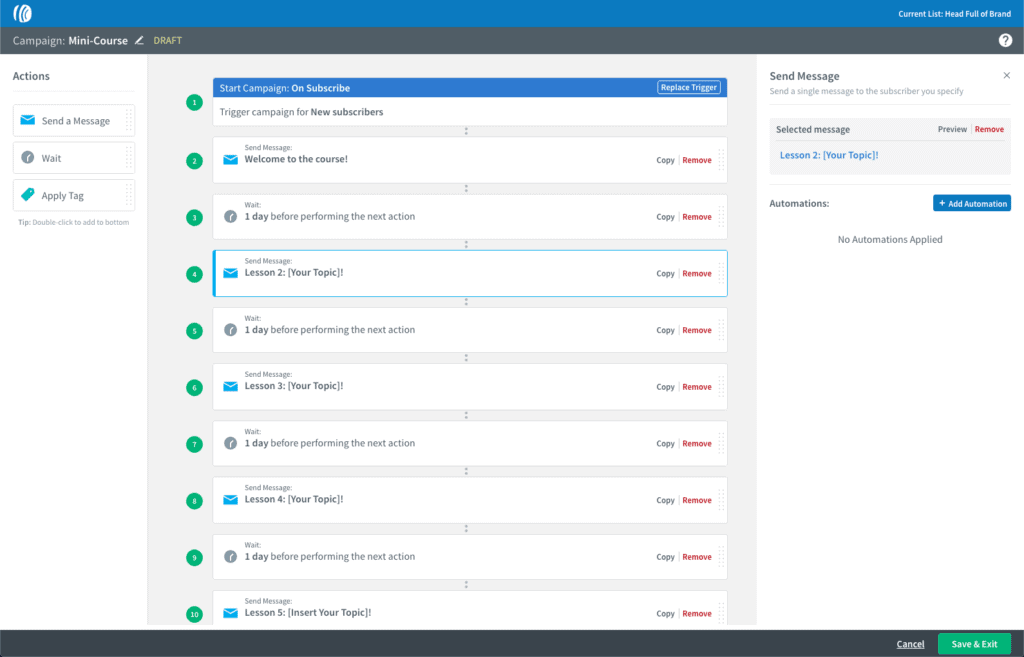
Another great SMB solution is AWeber. Unlike some other email marketing tools, they market their services specifically for this market.
With AWeber, you have access to a variety of list-building materials, as well as templates to create the perfect backdrop for your bulk emails’ content. Automation of emails is easy, to keep you working on more important things. There’s also a variety of mobile apps to help send bulk emails away from the computer. I like the fact that AWeber allows you to collaborate with others using the same user account, which reduces the need to sync information from many sources.
Another selling point is the Pennsylvania-based customer service team, which is available 24/7. Do keep in mind, however, that this program ONLY does the email side of things. You’ll need other programs for CRM, Google analytics, etc.
It’s important to note that it is said that AWeber has excellent deliverability because all email subscribers must double opt-in. This means that even if you want to migrate to AWeber, your subscribers must opt-in again to your list on AWeber. This is a unique requirement among email service providers, and may prove difficult or frustrating for some email subscribers.
Here is a snapshot of Aweber features:
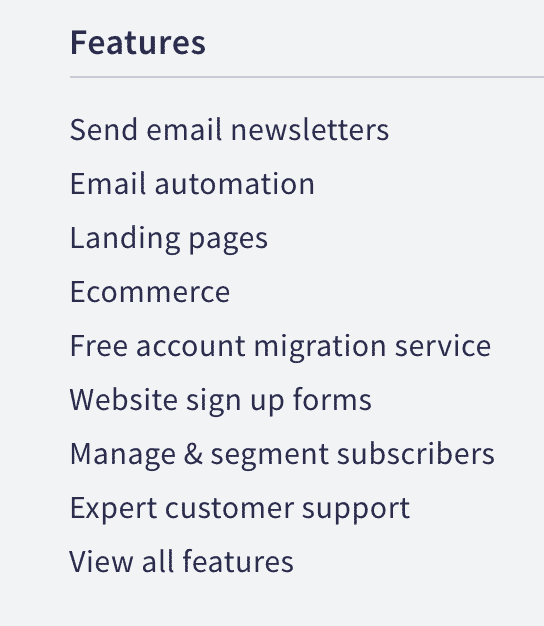
Pricing for Aweber is much simpler than ActiveCampaign, because there aren’t any service levels. If you have 500 subscribers, it’s a simple $19, while 2,500 and 10,000 subscribers are competitively priced at $29 and $69.

Need something with a permanently-free option? Benchmark offers a limited-feature free version of their software if you only send 250 emails per month. So, if you’re just starting out with email editors, this is a great way to grow your business while saving money. However, there’s definitely something for everyone. After all, there are plans even if you have tens of thousands of subscribers.
Once you get your first paid plan, you can use everything Benchmark has to offer. For example, everyone gets drag-and-drop email design features. On the other hand, paid subscribers can do their photo editing in the program, rather than having to use Photoshop or Canva to do this first. There’s a full range of templates and other goodies, as well, and at first glance, Benchmark looks fairly easy to use.
Here’s a summary of Benchmark features:

If the free version isn’t enough for you, the Pro version pricing for 500 subscribers is $14, for 2,500 subscribers is $32, and for 10,000 subscribers is $82.

Want analytics with your email campaign? How about a more personal touch? Campaign Monitor delivers both, in spades. They’ll tell you what’s working, and what isn’t, so you can improve your pitch for the next round. Another strength is that they have both responsive emailing rules based on past customer behavior, and they support customized emails to improve customer relationships.
Campaign Monitor also brags about their countdown clocks to create a sense of urgency. They also provide convenient features, such as the ability to allow you to see what an email is going to look like on different types of devices before you send it.
Pricing for Campaign Monitor is fairly complex, similar to ActiveCampaign, because of the rich functionality that they provide. If you have 500 subscribers, for instance, their 3 plans are priced at $9 per month for the basic plan, with more comprehensive plans at $29 or $149 monthly. You’ll definitely want to compare and contrast both pricing and features with the similar ActiveCampaign if you want the advanced functionality that they have.
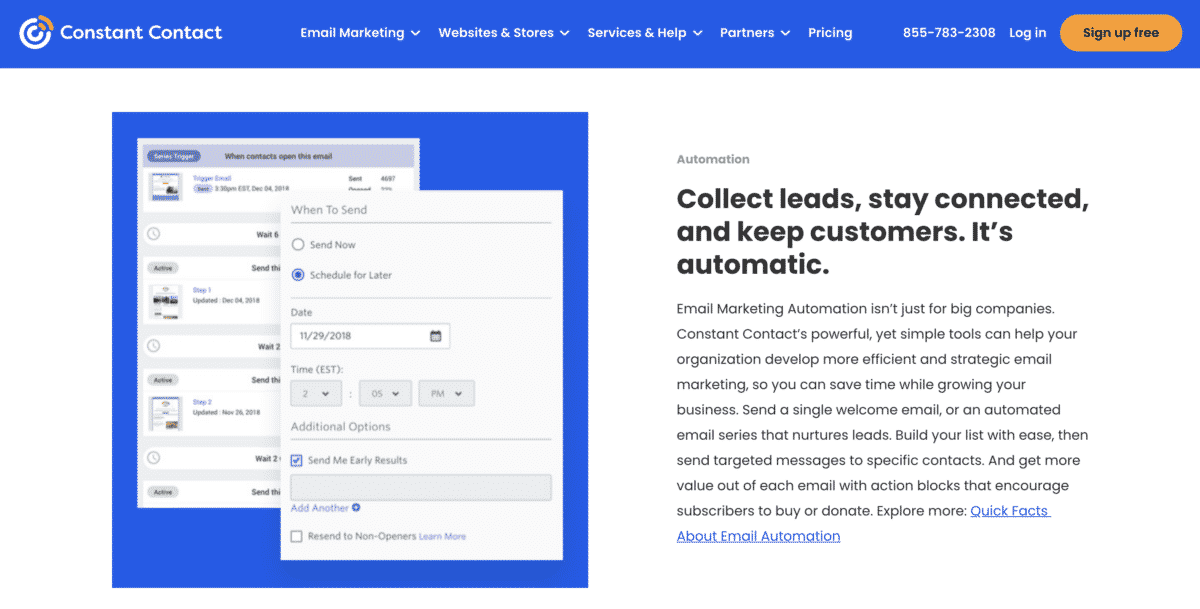
Constant Contact was the first email marketing solution that I ever used more than a decade ago, and they have been a staple product in the industry.
It’s another tool that’s built for even the smallest businesses, but scalable for use by medium-sized ones, and is easy to use,to boot. With both basic and advanced email marketing plans, there’s something for everyone.
My own observation shows that Constant Contact is super popular with nonprofits such as religious and community organizations. This isn’t surprising, because this company also offers Website and marketing consultation services. And, rather than allow your email list to grow with junk contacts that you have to pay them for, Constant Contact removes email addresses when customers consistently don’t open the emails. They also remove “burner” email addresses, saving you money and improving your engagement rates.
Here’s a snapshot of Constant Contact’s features:

As for ConstantContact pricing, there are two basic plan types, called “Email” and “Email Plus.” For 500 subscribers, it’s $20 for “email,” and $45 monthly for “plus,” while the splits at 2,500 subscribers and 10,000 subscribers are $45/$70 and $95/$125.
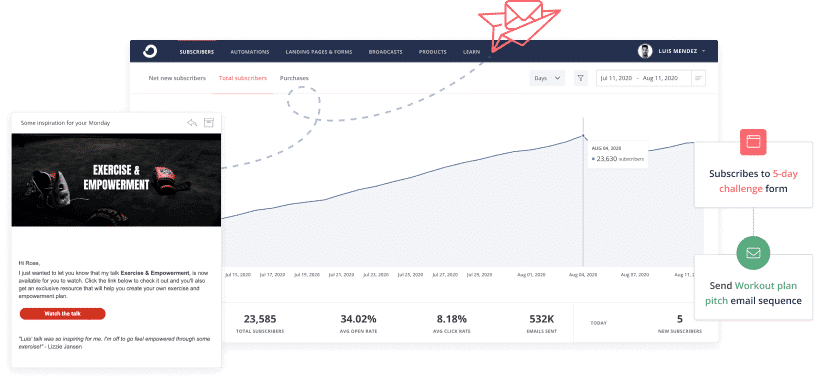
ConvertKit is the email marketing service I moved to a few years ago when they were the new and shiny email marketing solution used by a lot of bloggers. Since then, they have only become more popular with bloggers. I migrated away from them because I didn’t feel that they innovated their product fast enough for my digital marketing needs.
Fast forward to more recently where, as mentioned in the pricing for ActiveCampaign above, their rates were competitive until you hit 10,000 subscribers. After hitting that, and realizing that ConvertKit has innovated a great deal recently, I have moved back to ConvertKit and haven’t looked back, even recommending it to some of my clients as an alternative to ActiveCampaign based on their needs.
Simply put, if you are looking for an email marketing tool that includes tagging and marketing automation, ConvertKit might be the best choice out there for you.
When I moved from MailChimp, I noticed that graphical email templates were not one of ConvertKit’s strength. In fact, if you want to get your point across and think your subscribers would prefer plain-English, non-flashy email, you will enjoy the minimalist look of ConvertKit’s emails. For this reason, ConvertKit is a great choice for businesses that are more service-oriented, or who sell technical products and can easily make use of ready-made templates. The design templates are perfect for niches where gimmicks are not wanted or appreciated. Otherwise, this program works like most others.
Here’s what an overview of ConvertKit’s features look like:
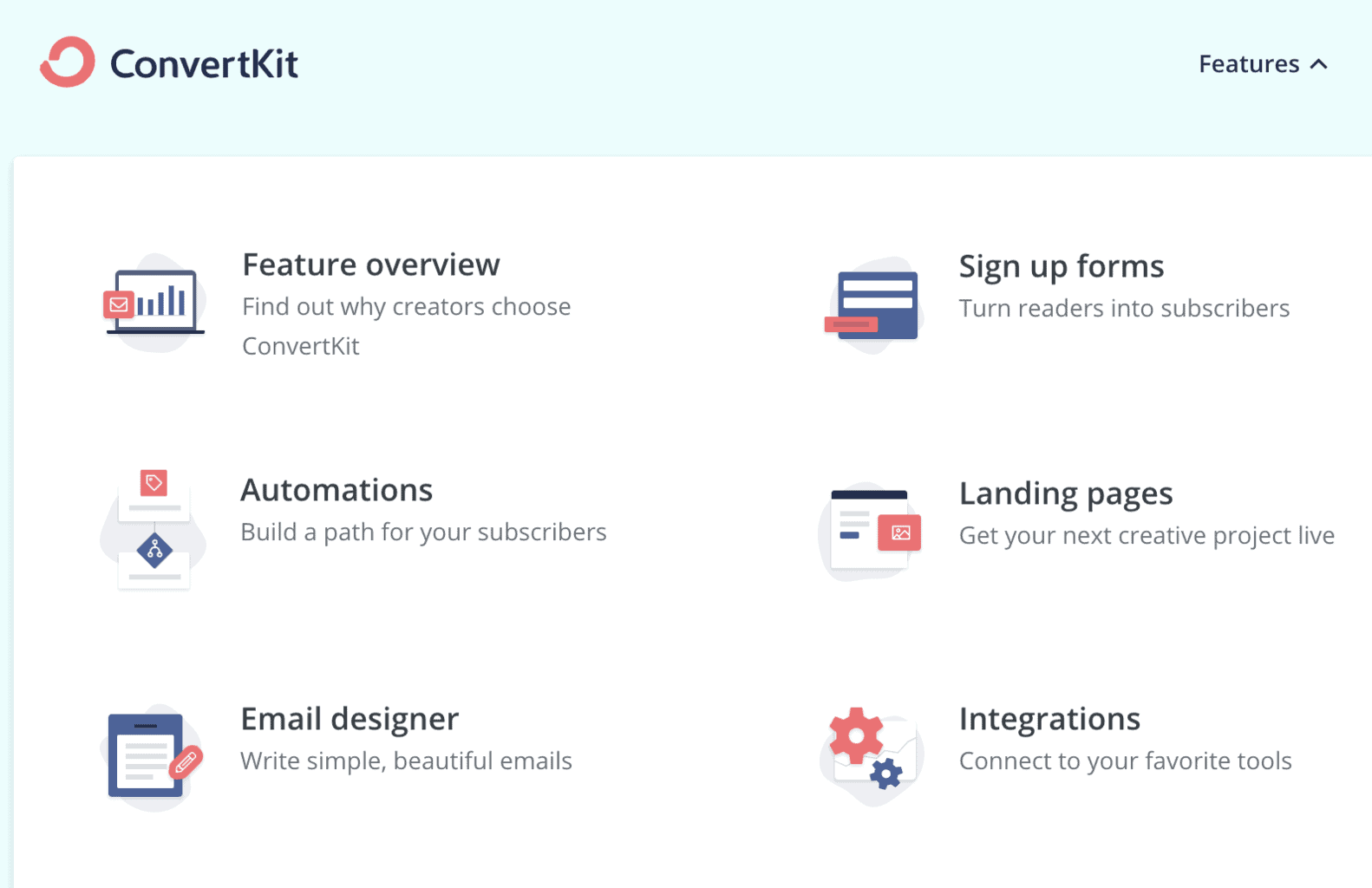
ConvertKit offers a free plan for up to 500 subscribers. After that, pricing is super simple: $29 per month for up to 1,000 subscribers. Beyond that you are looking at $49 for 2,500 subscribers and $119 for 10,000 subscribers.
For a further look at ConvertKit features, check out this video I made on just that!

I was introduced to Drip about the same time I was introduced to ConvertKit. One of my friends chose Drip, which I thought was fairly similar in functionality in ConvertKit, while I chose CK. Then the landing page provider LeadPages announced that they had acquired Drip. And the rest is history! If you are a LeadPages user, Drip is an attractive integrated solution, but even if you don’t use LeadPages, Drip deserves your consideration.
If you have a small ecommerce site or are looking to market a brand, Drip is the type of tool you need. That’s because their emphasis is on customer analytics, and the features are designed more for products and ecommerce than services. Analytics show you what the customer is interested in after they browse your website, and this helps you know what specific products to sell with the next email blast. This is a powerful feature for generating actionable insights and learning how to better sell to your full email address list.
As an email marketing service provider, Drip also is a champion at customization, which is a popular email strategy with younger product consumers. But perhaps the coolest feature is the ability to re-send an email to customers that don’t open it. It’s almost like turning back the clock and driving more responsive emails.
An overview of Drip’s features show just how different they are from other solutions here in terms of how they position themselves:

After a free trial period, customers with 2,500 subscribers or less pay just $49 per month. However, when you reach 10,000 subscribers that number jumps to $184.
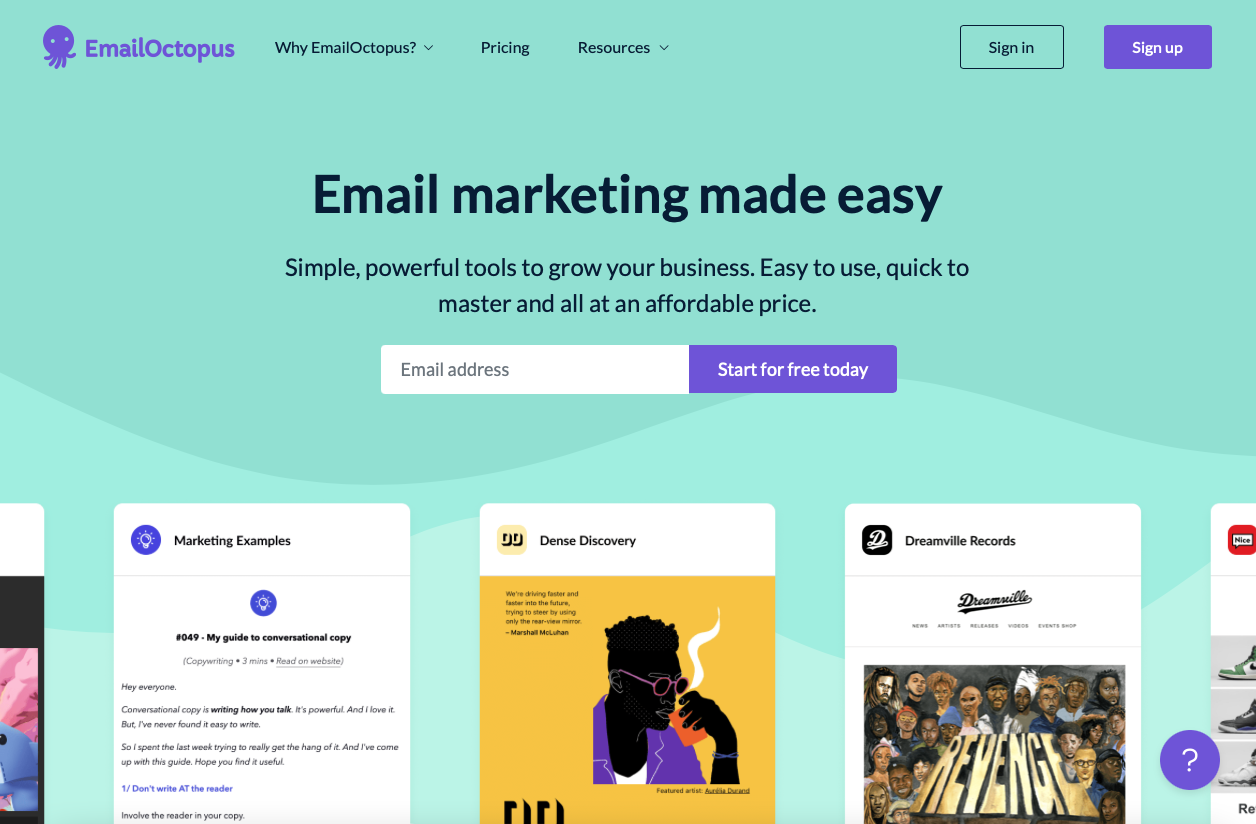
EmailOctopus is among the smaller operations out there. As a 100% independent startup, EmailOctopus is made up of a small team of workers, all devoted to providing customers with superlative quality and unmatched customer service. With a sleek, open, and friendly design and site, EmailOctopus is a great company for smaller startups, bloggers, and other parties with an eye on design and simplicity.
EmailOctopus is aimed toward growing an audience, rather than simply connecting with an audience. EmailOctopus is also designed to maintain sustainable and ethical principles, designing a business around the idea that email marketing should be simple, streamlined, good for the company, and good for the planet. If youthful flair and an eye on sustainability are in your wheelhouse, EmailOctopus may be the email marketing company for you.
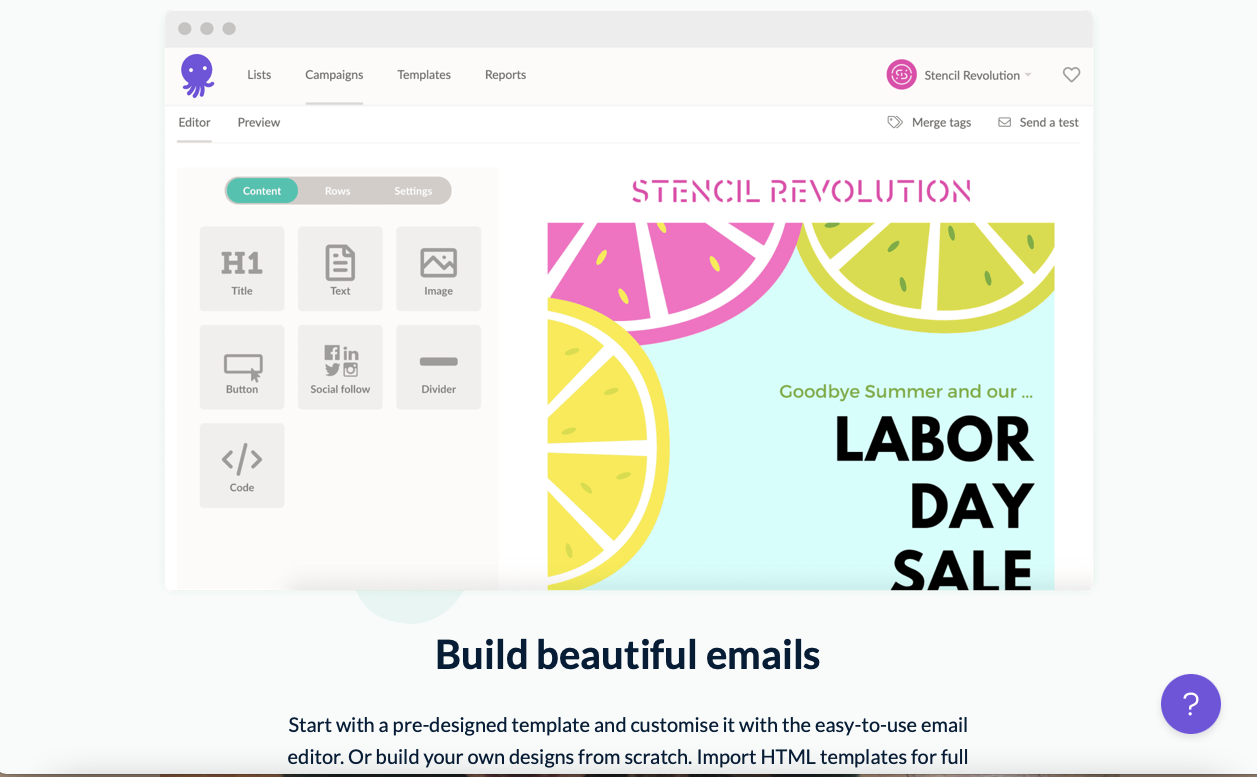
EmailOctopus has two different pricing tiers: the free version of the service and the Pro version of the service. Free EmailOctopus has very basic availability: up to 2,500 subscribers, 10,000 emails each month, 30 days’ worth of reports, and basic support.
The pro version of EmailOctopus is a different model than most, in that it scales according to the size of your business. Starting at $20 per month for 5,000 subscribers and 50,000 emails, priority support, customized designs, and unlimited email reports, EmailOctopus pro can reach as high as $910 per month for 480,000 subscribers and 4,800,000 emails. Subscribers and bulk emails higher than that require a personalized quote.
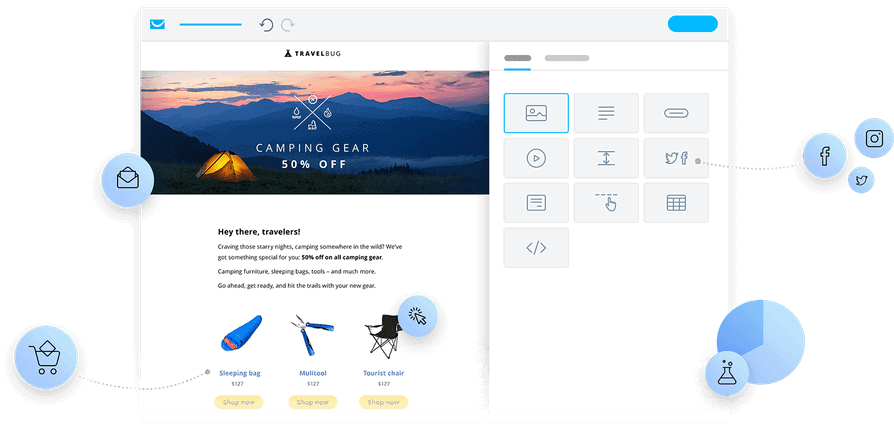
GetResponse is an email marketing service provider that I have started using recently and, while different than ActiveCampaign in terms of their features, provide a fully functional solution at a reasonable price even as your subscribers grow.
Those of us who have a large email list and only want to send emails can really benefit from GetResponse. This is one of the oldest names in email marketing, and they’re still around for one important reason: ease of use. However, the program is getting more sophisticated now, and you have to pay more to get all the available features. For example, you’ll need a plus account or higher to integrate GetResponse with your social media accounts or generate autoresponders as part of your email strategy.
They have a number of mobile-friendly options, provide Shutterstock images, and have some killer functionality, such as the inclusion of a webinar platform as well as the ability to create automated lead magnet funnels using their landing page and marketing automation functionality.
A snapshot of GetResponse’s features will give you a feel for the functionality that they support:

GetResponse’s pricing is more complicated than most because of their rich functionality. For an email list of 1,000, pay just $15 per month for a Basic plan, $49 for Plus, and $99 for Professional. These prices go up to $25 / $59 / $119 at 2,500 subscribers and $65 / $95 / $165 at 10,000 subscribers. Know what you need before you buy. I have subscribed to the Plus plan on this popular email marketing service, which includes webinars, and have found it to be sufficient.
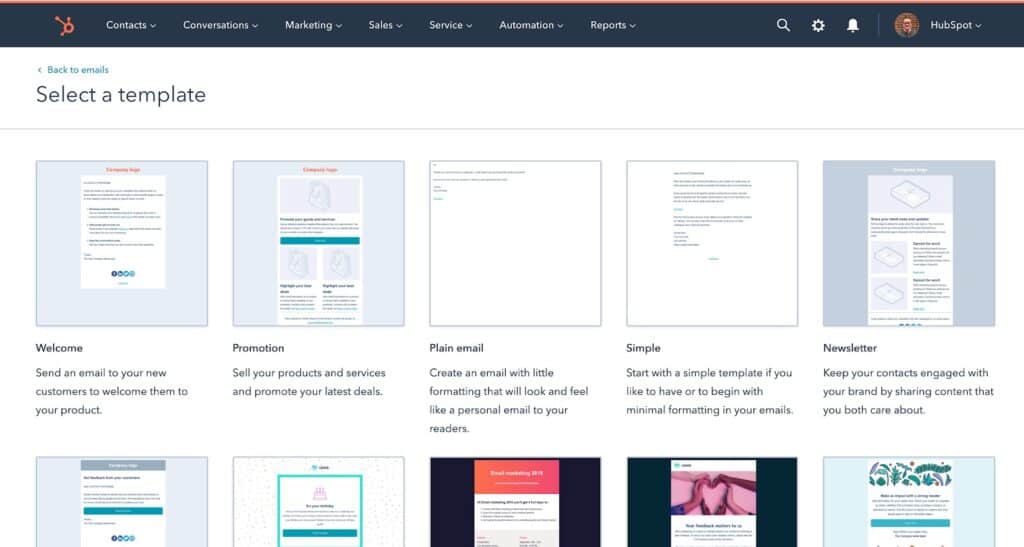
HubSpot literally invented the term “Inbound Marketing,” and they were one of the first to truly integrate search, social, and email into one product to more effectively create and support engaging, responsive emails.
Are you starting your company from scratch? Do you have a super-thin profit margin? In either of these situations, you can benefit from HubSpot. Unlike many other email marketing providers, they do have a number of email marketing tools that are free to use long-term, without a 14-day free trial.
As long as you don’t need the features of a paid version, you can keep using HubSpot for free. So, what comes with free? Basic tools that’ll get you started. Best of all, when your company grows and needs change, you can stay with the same company by upgrading to their Starter plan without losing track of your customer journey.
Here’s a look at all of the free marketing tools that HubSpot offers:
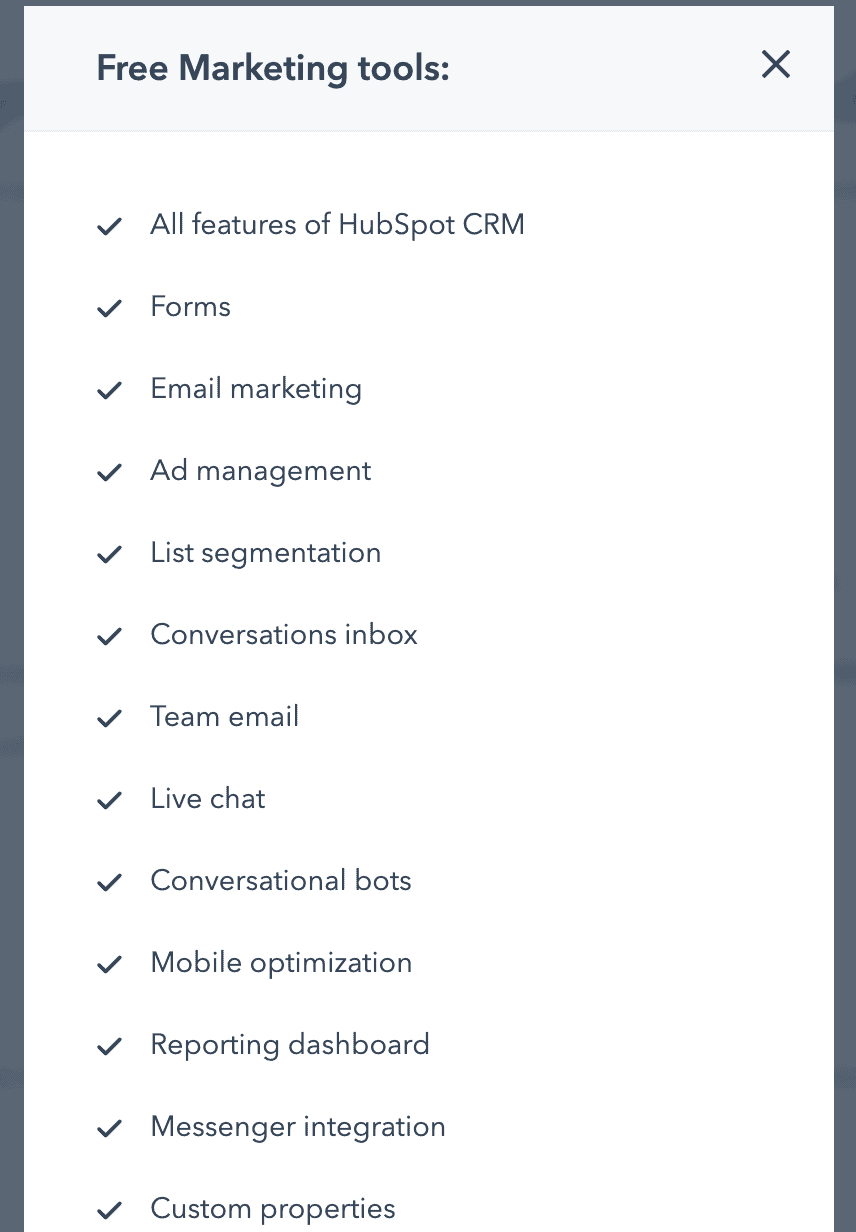
What is confusing about HubSpot is that they have developed solutions for Marketing, Sales, Services and a CMS. Furthermore, while most of these have starter plans under $100 a month, they quickly go into the hundreds if not thousands of dollars a month.
Wen you want to go past the free tools, HubSpot pricing is based on which services you want and how many people are using it. Looking at the Marketing Hub product, the $50 a month basic plan includes 1,000 contacts, but the more fully featured Professional plan is priced at $800 a month for the same 1,000 contacts.

Are you running a nonprofit? That’s good, because iContact offers a discount to nonprofits. They consider it part of their corporate citizenship, and the software itself is great for this type of business. With that said, iContact is great for other businesses, as well.
While they offer the usual full range of email marketing features, the strength of this platform is ease of collaboration. That’s because they allow multiple users to access the same account. This popular email marketing service also has excellent social media integration and even has the availability of marketing coaching through customer service channels. These guys love helping their customers grow!
Here’s an overview of iContact features:

iContact has a basic plan as well as a Pro plan which includes automations, landing pages, segmentation, etc. The breakdown for the two is $15 / $30 for 500 contacts, $36 / $72 for 2,500 contacts, and $89 / $178 for 10,000 contacts.
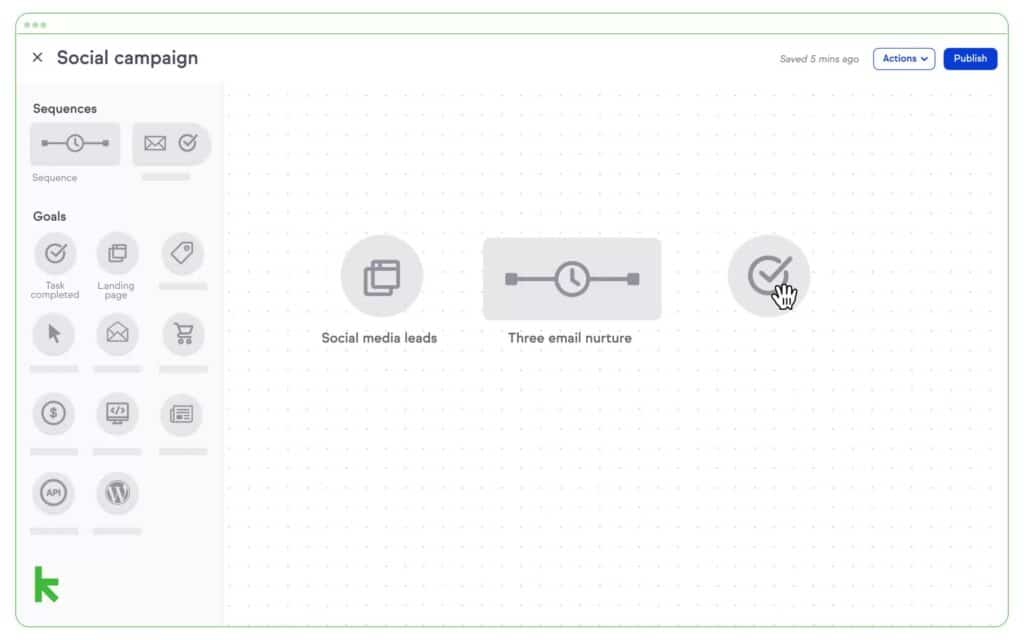
I have a long history with Keap, going back to when they were known as InfusionSoft. I even attended their InfusionSoft University at their offices in Phoenix back in the day. Although they have always had a powerful software stack, actually using it was always a challenge for me and many users. I am hoping that Keap has made their product easier to use.
That being said, small businesses that need the templates and market advanced segmentation will love Keap. That’s because they not only allow you to send a lot of emails efficiently, but they have a track record of high open and conversion rates. In other words, Keap really can free you from fruitless email blasts. Who wants those?
Yet, Keap goes far beyond email to offering a full range of automated CRM tools, including mobile messaging with customers (great for repair contractors), and appointment setting tools (excellent for the service industry).
Keap were one of the innovators in the small business marketing automation space and were the default used by many bloggers and small businesses back in the day…
To compare and contrast with other email marketing tools, here’s a snapshot of Keap’s functionality:

Monthly pricing varies based on level of service and number of contacts. The least expensive plan, which provides basic email marketing and CRM functionality, is $79 per month for one user and 500 contacts. As you can see the business model is more geared towards enterprises, but if you want to make them your strategic engine for small business CRM and marketing, the investment would be a wise one to make to turn leads into customers and build email workflows.

Mailchimp is the default beginner’s email marketing software today as Constant Contact was back in the day. Mailchimp became the default because of their free plan.
Small subscriber list and a smaller budget? Mailchimp is an excellent choice, because if you have fewer than 2,000 subscribers, it’s free. Besides the low cost, however, Mailchimp is also easy to use. That’s especially true if you’re sending simple messages like the community group newsletter to a few people. Since it’s free, you could even use it to email family and friends with the latest on your adoption fundraiser, for instance. The program also has the analytics and other basic customer insights features you’ll need to start a new business.
That being said, if some of the automation, segmentation, tagging et. al. advanced functionality that you see some of their competitors excites you, Mailchimp is probably not the best choice for you. I have found that they are not as innovative as many of their competitors, and while some advanced functionality such as automations exist, they are hard to use.
Mailchimp does suffer from having multiple tiers of products with a complex mix of functionality as you can see below:

Monthly pricing for Mailchimp depends mostly on the services you need. After you’ve reached 2,000 subscribers, the cheapest option is $10 monthly for their Essentials plan. At 2,500 subscribers their Essentials and Standard plans are $30 / $50 while at 10,000 subscribers are $75 / $100.

I have recently started using MailerLite and am a big fan of its simplicity and ease of use while delivering on the functionality of much more expensive solutions with tagging, automations, and pop-up forms.
For those of you who prefer a “no frills” email provider, MailerLite is a great option that has a limited-feature free plan for smaller lists. It also has a limit on how many monthly emails you can send, which makes it great for freelancers. Even the paid version has fairly limited functionality, however. Even so, there are some email and newsletter templates for customers to use. They also include basic automation features such as the sending of welcome and order confirmation emails, which are great to make sure you are reaching your target audiences immediately after signing up for your newsletters.
You would think, based on my description above, that MailerLite would be limited in functionality, but that’s actually not the case, as you will see below!

MailerLite has a free plan that is limited to 1,000 contacts and 12,000 emails. However, for $10 per month, that same size list loses its quantity cap. Up to 2,500 users will cost $15 while 10,000 users will only cost you $50. From a cost-performance perspective, it’s hard to beat MailerLite as a campaign builder.

Large teams with an IT department or well-established branding do well with Mailjet. In fact, this one is used by enterprise-level clients like Microsoft. However, they do perform for smaller businesses, too. Mailjet is one of the few email providers with STMP relays and direct API access, rather than just a slick user interface. They also have a text messaging feature to confirm transactions. Need GDPR and ISO compliance? Mailjet is certified in both protocols, so you can rest easy.
The below should give you a feel as to how more technical Mailjet’s solution is:

MailJet has a complex 4-tier pricing plan which is based on numbers of emails sent, not number of subscribers. The free plan offers you 6,000 free emails per month, while the core plan allows you to send out 30,000 emails per month for $10 for the Basic plan or $21 for the Premium plan. If you don’t send out many emails per contact, Mailjet might be a very economical solution for you.
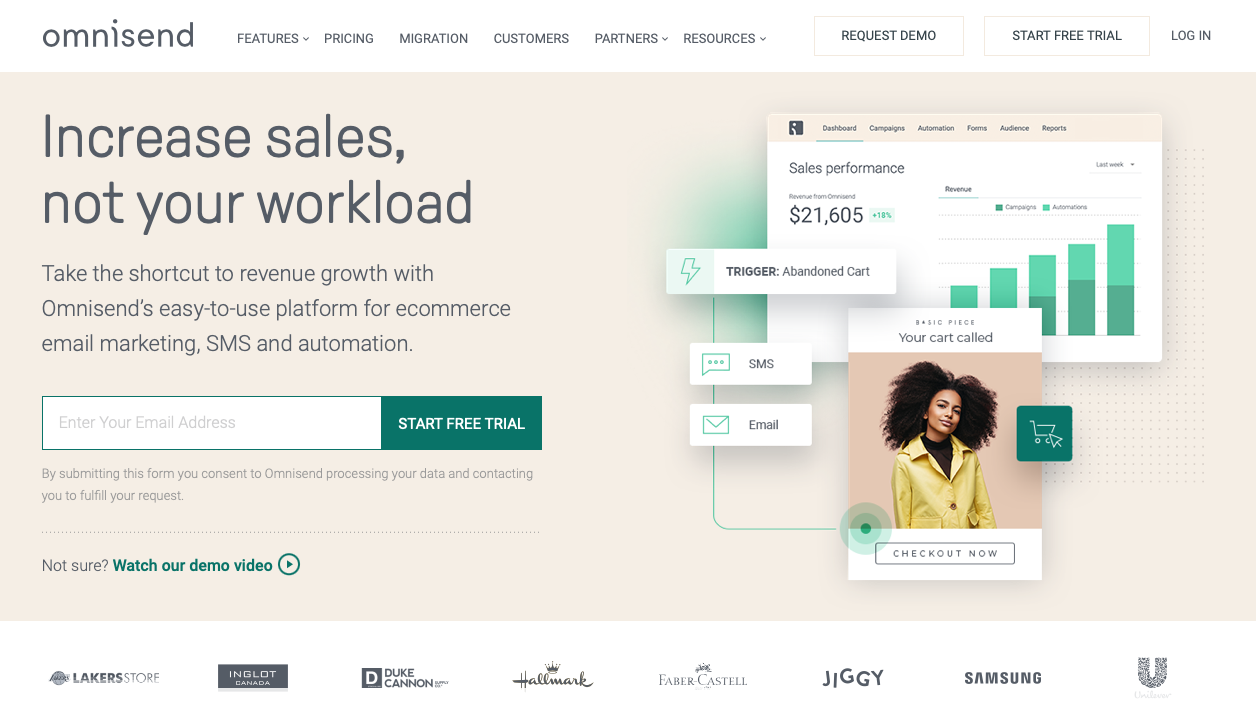
Omnisend is a full-service platform. Omnisend is an email marketing service that offers beautiful emails to drive e-commerce and transactional emails. Omnisend’s email marketing platform offers automation, marketing templates, pop-up menus and more. Omnisend allows you to be as customized as you want or as easy to build as you’d like, using what amounts to a drag-and-drop email builder to create transactional emails that are as easy to use as they are attractive.
Omnisend’s backend marketing email dashboard is fairly simple and straightforward and lacks some of the flair a newer and more youthful email marketing service might have but more than makes up for it with functionality. Like all other bulk mailing list services, you can alter subject lines, how many emails per day are sent, and how personalized emails actually are. Omnisend is great for email marketing efforts that are focused more on driving sales than building a stronger network.
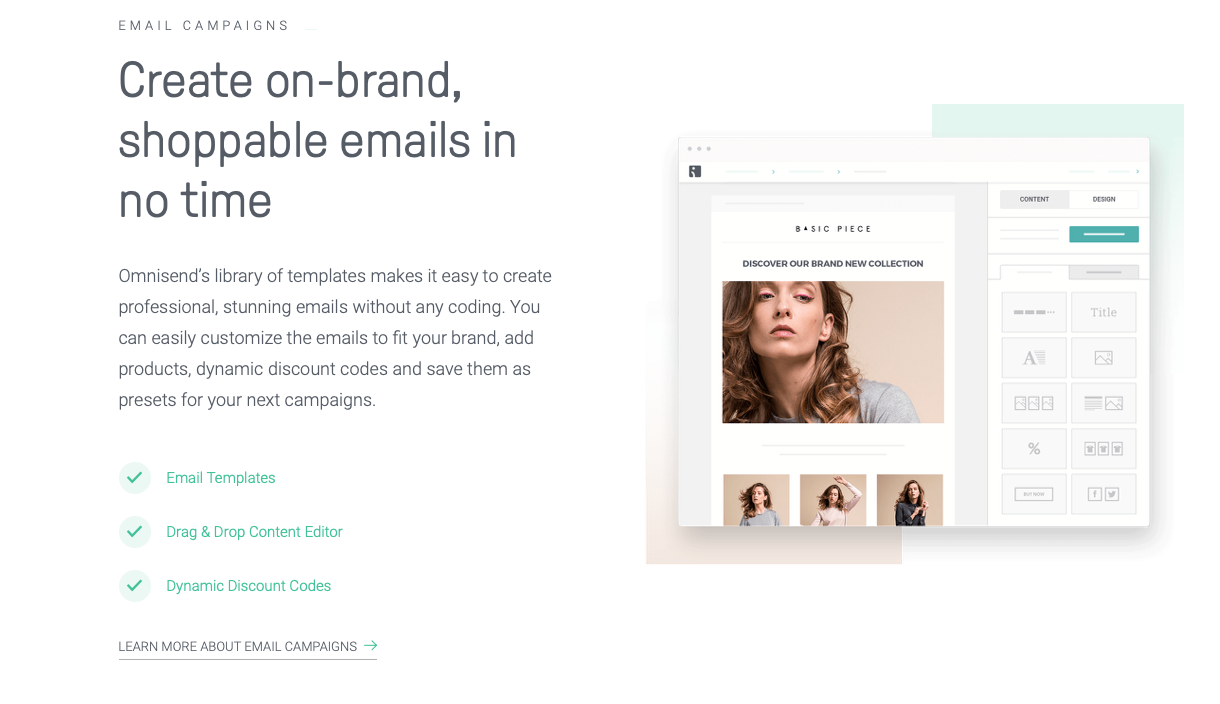
Omnisend’s pricing plans come in four different tiers. The first tier offers email marketing for free, and although it is useful, it does not offer any of the advanced features afforded to more intense or large email marketing campaigns. Omnisend’s next tier offers personalized emails for $16 per month. Like the free tier, it offers 15,000 emails each month, along with 24/7 support, SMS messaging, automation, and workflows.
The next tier offers email marketing campaigns for $99 per month. This email tool provides subscribers with the same 15,000 emails per month, but offers additional features, such as a success coach, web push notifications, audience syncing, and advanced reporting. The final tier provides a sales team with unlimited bulk emails, all of the tools offered on the lower email platform, and email account migration, additional support, and a custom IP address.
For companies that rely heavily on real-time contact with customers, SendinBlue is an excellent option. That’s because they offer quite a bit more than just email, without being an all-in-one email marketing tool. Specifically, SendinBlue gives you the option of sending text messages, chatting with customers, and inserting a chatbot into your website. These chatbots report back to you as necessary. In other words, SendinBlue is designed to meet a variety of customer communication needs.
Actually, when comparing MailerLite, SendinBlue was the closest comparison I could find, and I was very happy with the support I got with my product questions, even though I wasn’t a customer!
Here’s a quick snapshot as to what SendinBlue supports from a functionality basis:

Similar to the above MailJet, SendinBlue is also a French company and also prices according to number of emails sent, not number of subscribers. That being said, SendinBlue has 5 different price tiers, with the free plan offering 300 free emails per month, $25 a month for 40,000 emails, and $39 a month for 60,000 emails.

Smaily is one of the newer companies that I have been recently introduced to that I think bear mentioning on this list as another alternative. What differentiates Smaily is that they were created with the intention of making email marketing accessible to everyone and therefore is intended mainly for small and medium-sized businesses, but is also able to cater to the needs of bigger enterprises.
Smaily offers its users an easy-to-use tool to build beautiful custom newsletters without having to know anything about coding. A unique differentiator of Smaily is that you can even ask for some additional assistance beyond normal customer support, as they actually offer both copywriting and design services, as well. Once you’re done with the newsletter, it’s easy to import contacts onto your account, segment them, set up your campaign, and send it on its merry way.
What’s great for both your campaign results and budget: Smaily removes all inactive contacts and duplicates from your emailing list, so you don’t have to pay extra for them. Not every email service provider does this.
There’s a variety of automations to choose from and you can build your own automated workflows with as many steps as you desire. You’ll also be able to integrate Smaily with a lot of other third-party apps and platforms for easy data syncing.

If you have up to 2,000 subscribers and don’t mind their small logo in the footer of your newsletter, using Smaily is completely free on par with many other email service providers. If you’re looking for priority support and no logo, your price for 5,000 subscribers would be $41.23 and 10,000 subscribers $73.51. Note that prices are based on Euros and are priced per 500 subscribers. If you only send out campaigns a few times a year, you can also opt for inexpensive pay-as-you-go credit points.
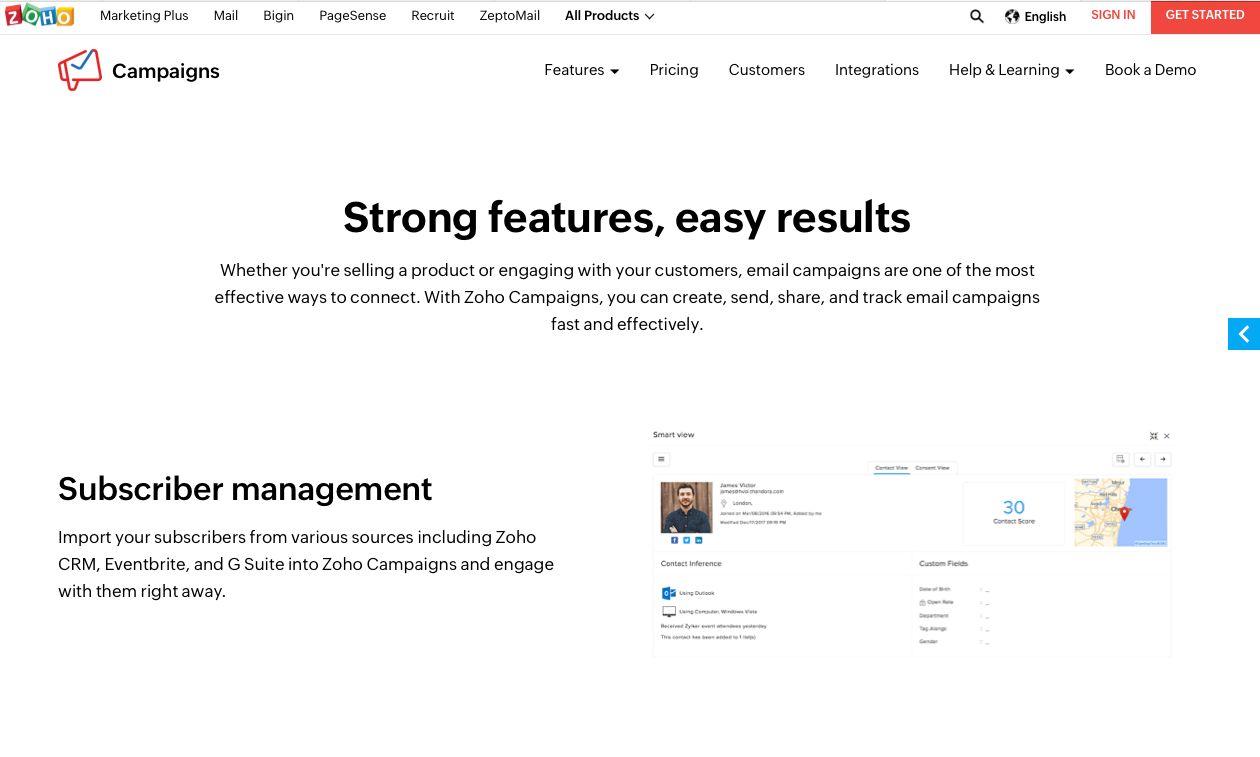
Zoho mail is a full-service email service. Through Zoho, you can craft an email newsletter, engage in customer relationship management, communicate with others inside of your organization, provide sign-up forms, and more. Zoho’s email marketing platform is just one facet of a larger service. From bulk emails to business and communication management tools, Zoho is a powerful tool for more established business in need of an email tool that can also manage email marketing campaigns.
Zoho campaigns offer drag-and-drop design options that allow you to create powerful marketing campaigns in record time. With plenty of pre-determined templates, different ways to measure email performance, and tools to create effective email campaigns based on feedback from past email clients, Zoho is a great option for established businesses that are looking to streamline products and apps, and are in search of an all-in-one email inbox, email marketer, and marketing automation platform.
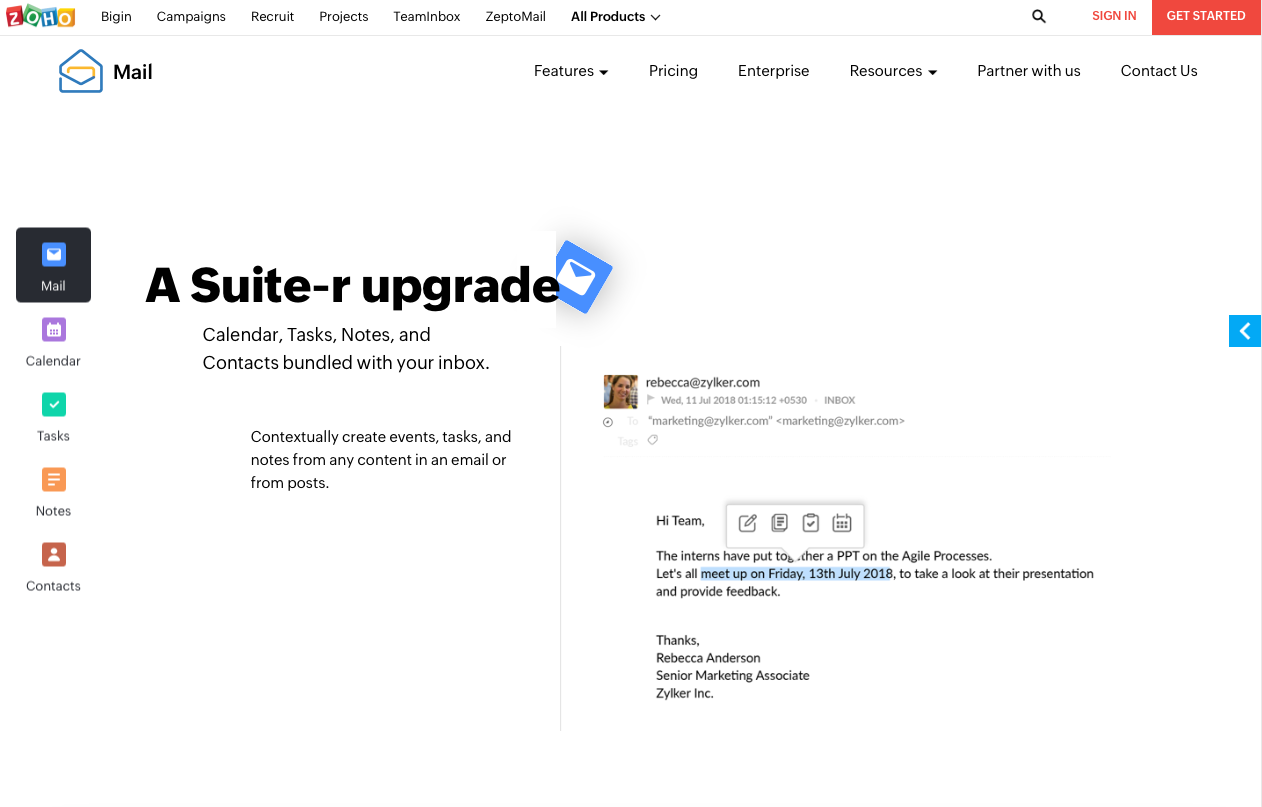
Because Zoho offers more than just email campaigns, there are much different approaches to email marketing through Zoho. The first price point for Zoho is for people who are not already using Zoho email services. Zoho pricing in the absence of a Zoho email subscription is charged according to emails. Starting at $3 per month for 500 emails (billed annually), non-subscribers can pay for additional emails as needed.
For subscribers to Zoho email services, prices are made according to the number of subscribers you have. Emails are unlimited, and can be sent to your list of contacts. Subscribers are rewarded with more batch sending, email polls and form submissions, and marketing automation tools.
The final tier for Zoho campaigns involves purchasing credits for emails. This tier is ideal for companies who do not need unlimited contacts or emails, and who send out marketing emails only occasionally. Credits can be purchased and used according to monthly or even yearly needs, and emails do not possess advanced segmentation tools, signup forms, or other advanced tools offered in the previous two tiers.
Wrap Up
So, there you have it: My perspective on the best 19 email marketing tools that exist. What are your favorite email marketing tools?
Let me know in the comments!
Hero photo by Solen Feyissa on Unsplash